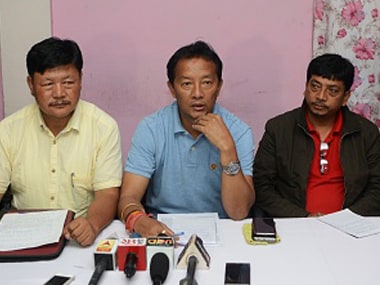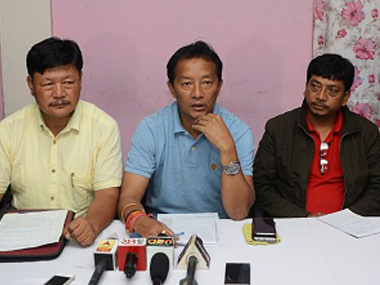With the demand for a “Gorkhaland” state to be carved out of West Bengal’s hill districts of Darjeeling and Kalimpong and their contiguous areas up in the air, presently relegated to the baseline of local discourse, recent developments, coming as they do ahead of the upcoming Lok Sabha polls, indicate that politics in the region could well be set for a tangential course in the near future. [caption id=“attachment_4120327” align=“alignleft” width=“380”]  File image of Binay Tamang (centre). Getty Images[/caption] The proposal, made public earlier this week, of the dispensation that constitutes the governing authority in the hills to press for constitutional recognition and legislative powers for the quasi-autonomous regional body – the Gorkhaland Territorial Administration (GTA) – set up initially as an extension of a design to keep the lid on the revival of statehood campaign, is a sign of things to come. What deserves special mention, however, is that the announcement that came in the wake of a two-day “Chintan Sabha” (brainstorming session) in the foothills of the Binay Tamang-led faction of the Gorkha Janmukti Morcha (GJM) which is the principal political formation in the region carries with it the need to safeguard, among other things, the territorial integrity and identity of the local Gorkha community – issues that were the rallying call for the statehood campaign and which have been lodged in the popular imagination since the mid-1980s. Tamang, who assumed leadership of the GJM after ousting fugitive leader Bimal Gurung from the helm, and also was placed in charge of the GTA’s Board of Administrators (BOA) by Chief Minister Mamata Banerjee in September 2017, has admitted on more than one occasion that the statehood stir was ill-conceived and its timing not quite right. The move, instead, for constitutional status to the GTA and vesting the body with law-enactment powers, is being mooted as one based on “practicalities” and ground realities without overtly compromising the statehood demand. In one fell swoop he not only apparently seeks to discount charges levelled at him by his detractors — chief of whom is Gurung — of betraying the Gorkha cause by warming to Banerjee, but also ensures the maintaining of a working relation with a state government that leans heavily on him to prevent any recurrence of stirs for Gorkhaland like the most recent and occasionally violent 104-day June-September, 2017, shutdown in the hills. The state has also extracted from Tamang an assurance that there will be no more such strikes in the hills. Whether or not this proximity with Banerjee could coalesce into an electoral alliance of the GJM and her Trinamool Congress in the coming parliamentary polls is the question doing the rounds in local political circles. Tamang is keeping his cards close to the chest but has made clear that his party will, unlike the two previous elections, have no truck with the BJP. Were it not for the support of the GJM – then under the stewardship of Gurung – the BJP would not have been able to come up trumps in the Darjeeling seat and it still banks on the support of Gurung and his acolytes to replicate its success. What remains to be seen is whether the leader who has been on the run is in any position to retrieve, even in absentia, the ground wrested from him by Tamang.
While the GJM remains unquestionably the major local player, the battle for the Darjeeling constituency is a key one — arguably one of the most prestigious seats in the state – for both the BJP and the Trinamool Congress, both of whom depend substantially on the support of the GJM which itself is a divided house with the factions led by Gurung and Tamang pitted against each other although the latter’s being predominant.
The rivalry within the party has recently been accentuated over the issue of the granting of Scheduled Tribe status to 11 local communities, something which the Centre is yet to deliver on, thus severely damaging the prospects of the BJP. Added to this is the failure to live up to the assurance by Union Home Minister Rajnath Singh way back in September 2017 to convene tripartite talks involving it, the state government and the GJM for a lasting solution to the outstanding political problems of the region. Banerjee’s party, on the other hand, is pinning its hopes on Tamang’s support. For, after all, his rise to prominence on assuming powers within the GTA is largely credited to the chief minister, as is her summary banishment of arch adversary Gurung into political limbo. The recent “Chintan Sabha” Tamang had organised is also significant, given that it was an opportunity to establish the political credibility of the GJM by articulating — without harping on the singular statehood demand — an agenda for the future for the first time since he took over control. Now that there has been the call for constitutional recognition and legislative powers for the GTA, the question is how much longer does the region wait for elections to the body due for well over a year. Though on yet another extension, the BOA by definition is a nominated grouping and functionally an ad hoc arrangement. He too has reportedly sought for elections to the GTA soon, to at least burnish his own political credentials if not anything else. A clearer picture of what the future holds for the hills can only emerge once they are held. The decision is for the state government to take. Till then the sights of all concerned will remain firmly trained on the coming Lok Sabha polls.


)
)
)
)
)
)
)
)
)



